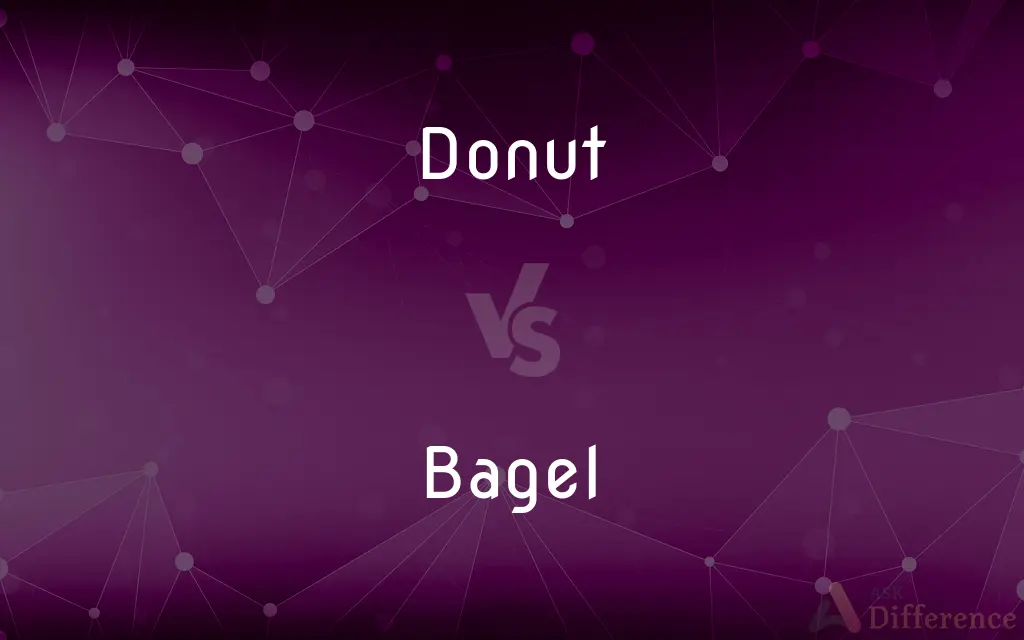Donut vs. Bagel — What's the Difference?
Edited by Tayyaba Rehman — By Urooj Arif — Updated on March 16, 2024
Donuts are sweet, fried pastries often glazed or filled, while bagels are dense, boiled-then-baked breads with a chewy texture.

Difference Between Donut and Bagel
Table of Contents
ADVERTISEMENT
Key Differences
Donuts are typically sweet treats made from a light, airy dough that is deep-fried and then either glazed, frosted, or filled with sweet fillings such as jam or cream. On the other hand, bagels are a type of dense, chewy bread made from a yeasted wheat dough that is first boiled in water before being baked, which gives them their distinctive texture and a shiny crust.
While donuts are known for their wide variety of flavors and toppings, including chocolate, vanilla, and sprinkles, bagels are often enjoyed with savory toppings such as cream cheese, lox, and onions or made into sandwiches. This difference highlights the versatility of bagels in comparison to the primarily sweet nature of donuts.
The dough preparation for donuts and bagels also differs significantly; donut dough is usually softer and enriched with eggs, butter, and sugar, contributing to their tender crumb and sweet flavor. In contrast, bagel dough is stiffer and only lightly sweetened or not at all, leading to a more bread-like texture and taste.
Bagels have a distinct boiling process before baking, which is essential for their texture and appearance, creating a dense, chewy interior and a glossy exterior. Donuts skip this step, going straight from shaping to frying, which results in a soft, fluffy texture and a golden-brown exterior.
Culturally, donuts are often associated with breakfast or dessert in many Western countries and are a popular choice for coffee accompaniments. Bagels, with their origins in the Jewish communities of Poland, have become a staple in American breakfast cuisine, particularly in New York City, known for its bagel culture.
ADVERTISEMENT
Comparison Chart
Primary flavor
Sweet, with varieties of glazes and fillings
Savory, often eaten with cream cheese or lox
Preparation
Fried
Boiled then baked
Texture
Soft and fluffy
Dense and chewy
Dough ingredients
Enriched with eggs, butter, and sugar
Yeasted wheat dough, less sweet
Serving suggestion
Often served as dessert or sweet snack
Commonly served as breakfast or sandwich
Compare with Definitions
Donut
A sweet, fried pastry often glazed or filled.
She enjoyed a chocolate-glazed donut with her morning coffee.
Bagel
A dense, chewy bread, boiled then baked.
Her breakfast was a toasted bagel with cream cheese.
Donut
Made from a soft, enriched dough.
The donut's dough includes butter and sugar, making it tender and flavorful.
Bagel
Boiled before baking for a chewy texture.
Boiling the bagels gives them their distinctive shiny crust.
Donut
Can be glazed, frosted, or filled with sweet ingredients.
He chose a donut filled with raspberry jam.
Bagel
Made from a stiff, yeasted wheat dough.
The bagel dough is less sweet, giving it a bread-like texture.
Donut
Typically enjoyed as a sweet treat or dessert.
They shared a dozen assorted donuts at the party.
Bagel
Often eaten with savory toppings.
For lunch, he had a bagel topped with lox and onions.
Donut
Deep-fried to achieve a golden crust.
After frying, the donut was light and airy inside.
Bagel
A staple in breakfast and sandwich cuisine.
She ordered a bagel sandwich with egg and cheese for breakfast.
Donut
Variant of doughnut.
Bagel
A bagel (Yiddish: בײגל beygl; Polish: bajgiel), also historically spelled beigel, is a bread product originating in the Jewish communities of Poland. It is traditionally shaped by hand into the form of a ring from yeasted wheat dough, roughly hand-sized, that is first boiled for a short time in water and then baked.
Donut
A deep-fried piece of dough or batter, commonly made in a toroidal or ellipsoidal shape, and mixed with various sweeteners and flavors, sometimes filled with jelly, custard, or cream.
Bagel
A glazed, ring-shaped roll with a tough, chewy texture, made from plain yeast dough that is dropped briefly into nearly boiling water and then baked.
Donut
Anything in the shape of a circle or torus.
Bagel
A toroidal bread roll that is boiled before it is baked.
Donut
A peel-out or skid-mark in the shape of a donut; a 360-degree skid.
Bagel
A score of 6-0 in a set (after the shape of a bagel, which looks like a zero).
Donut
(North America) A spare tire, smaller and less durable than a full-sized tire, only intended for temporary use.
Bagel
An overly materialistic and selfish young Jewish man.
Donut
A toroidal cushion typically used by hemorrhoid patients.
Bagel
(tennis) To achieve a score of 6–0 in a tennis set.
Donut
An idiot.
Nice going, you donut!
Bagel
(sports) To hold an opponent to a score of zero.
Donut
A small ring-shaped friedcake
Bagel
A glazed leavened doughnut-shaped roll with a hard crust.
Bagel
(Yiddish) glazed yeast-raised doughnut-shaped roll with hard crust
Common Curiosities
What's the main difference between a donut and a bagel?
Donuts are sweet, fried pastries, often glazed or filled, while bagels are dense, chewy breads, boiled then baked.
Can bagels be sweet?
While traditionally savory, bagels can be sweetened or topped with sweet ingredients like cinnamon-raisin or chocolate chips.
Do donuts have yeast?
Yes, many donut recipes use yeast to leaven the dough, although there are also "cake donuts" made with baking powder.
How do you serve donuts?
Donuts are often served as is, glazed, frosted, or filled, and can be enjoyed at any time of day as a treat.
What's the best way to eat a bagel?
Bagels are versatile and can be eaten plain, toasted with cream cheese, or used as the bread for sandwiches.
Can you make bagels without boiling them?
Skipping the boiling process results in a texture and taste that differs significantly from traditional bagels.
How did bagels become popular in the United States?
Bagels were introduced to the U.S. by Eastern European Jewish immigrants and became widespread, especially in cities with large Jewish populations.
What makes a bagel chewy?
The boiling process before baking is crucial for creating the bagel's signature dense and chewy texture.
Are donuts always fried?
Most traditional donuts are fried, but there are also baked varieties which are lighter in texture.
Is a bagel healthier than a donut?
Generally, bagels can be considered healthier due to their simpler ingredients and lower sugar content, but toppings can alter their nutritional value.
Why do bagels have holes?
The hole increases the bagel's surface area, allowing for a more even cooking and boiling process.
What are popular bagel toppings?
Popular toppings include cream cheese, lox, various meats, vegetables, and sometimes even sweet spreads.
Are there different types of donuts?
Yes, there are many types, including yeast donuts, cake donuts, and filled donuts, each with various flavors and toppings.
Can donuts be considered breakfast food?
Yes, donuts are commonly consumed for breakfast, often accompanied by coffee, though they are also popular as snacks or desserts.
Do donuts come from a specific culture?
Donuts are popular in many cultures but have become particularly associated with American cuisine.
Share Your Discovery

Previous Comparison
Taxonomy vs. Phylogeny
Next Comparison
Celsius vs. FahrenheitAuthor Spotlight
Written by
Urooj ArifUrooj is a skilled content writer at Ask Difference, known for her exceptional ability to simplify complex topics into engaging and informative content. With a passion for research and a flair for clear, concise writing, she consistently delivers articles that resonate with our diverse audience.
Edited by
Tayyaba RehmanTayyaba Rehman is a distinguished writer, currently serving as a primary contributor to askdifference.com. As a researcher in semantics and etymology, Tayyaba's passion for the complexity of languages and their distinctions has found a perfect home on the platform. Tayyaba delves into the intricacies of language, distinguishing between commonly confused words and phrases, thereby providing clarity for readers worldwide.














































